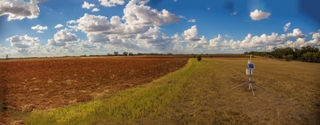Feb 4 2015
A new network of underground sensors in the Texas Hill Country will arm those responsible for managing the state’s finite water supply with vital information for determining the chances of drought and dangerous floods.
 Soil moisture sensors installed by the University of Texas at Austin will provide data to more accurately predict droughts and floods in Texas and to help a new NASA satellite predict weather on a global scale. (Image: Richard Casteel)
Soil moisture sensors installed by the University of Texas at Austin will provide data to more accurately predict droughts and floods in Texas and to help a new NASA satellite predict weather on a global scale. (Image: Richard Casteel)
The Texas Soil Observation Network (TxSON), run by the Bureau of Economic Geology at The University of Texas at Austin’s Jackson School of Geosciences, is connected to NASA’s new Soil Moisture Active Passive (SMAP) satellite, which was launched Jan. 31.
For Texas, a big payoff will be a solid estimate of how much water is stored in the soil. For NASA and the scientific community, the payoff will be the ability to predict weather on a global scale days or weeks ahead of time. NASA hopes to use the data to foretell drought and the potential for floods, wildfires and severe weather.
Soil is like a sponge — it can soak up a lot of water before rains recharge groundwater or run off into lakes and rivers. For regions experiencing extreme conditions, this means water may not make it into an increasingly strained water supply that is tapped by farmers, ranchers, fast-growing municipalities, power plants, oil refineries and natural gas drillers. Questions for Texas water planners include: How much rainfall will get sucked up by the soil, and how much will actually refill reservoirs? Or conversely, when there is heavy rainfall, what’s the chance it will turn into a dangerous flood?
TxSON will help answer those questions, said Todd Caldwell, a research associate at the Bureau of Economic Geology and the project’s leader.
“It’s now raining as it normally does in Texas, but the reservoirs aren’t filling up,” Caldwell said. “The soils are so thirsty that nothing is getting to the reservoirs.
As of January, lakes Travis and Buchanan, the major water reservoirs for Austin and most of Central Texas, are about a third full, and reservoirs throughout the state are about 65 percent full.
Even when it has rained during the past few years, the soil has been so dry that very little has made it to the lakes. Knowing how dry the soil is will be a vital piece of information, said Ron Anderson, chief engineer of water resources with the Lower Colorado River Authority, the agency that manages much of the water in drought-prone Central Texas.
“Do you know how many measurements we have for soil moisture and runoff? Zero,” he said. “There’s a huge gap between the rainfall measurement and the runoff measurement. The soil moisture monitoring allows us for the first time to maybe fill in that gap.”
Until now, when making flood forecasts and water supply projections, water managers have had to rely on their best guesses about what percentage of rainfall will replenish reservoirs.
“That means farmers downstream don’t know whether they’re going to get their water,” said TxSON project manager Michael Young of the Bureau of Economic Geology. “But we think we can predict what the reservoir storage will be a couple months ahead of time.”
Floods are also common in Texas and can be caused both by extreme wetness, when soil is oversaturated, or extreme dryness, when water flows over the ground as if it were concrete.
TxSON’s new soil monitors — which take a reading every five minutes — can help predict flash flooding. And they might even help water managers anticipate catastrophic floods such as the Onion Creek flood that killed five people in Central Texas on Halloween night in 2013.
NASA's SMAP: Mapping the Water Under Our Feet
Caldwell and his team installed 39 soil moisture stations in four months, a tight schedule necessitated by the Jan. 31 launch of NASA’s SMAP satellite. The $900 million satellite will measure the planet’s soil moisture every three days.
TxSON is among 30 contributing partners worldwide that will verify what is detected from orbit. The groundwater monitors will help calibrate SMAP’s measurements, said Simon Yueh, a SMAP scientist at NASA’s Jet Propulsion Laboratory.
The satellite will measure water in the top 2 inches of soil using two microwave devices — a radar sensor that sends pulses to the ground and measures the returning echo, and a radiometer that measures radiation emitted by the soil.
The key is collecting that information and making it useful to people who make decisions. TxSON and SMAP are vital tools for doing just that. Experts call soil moisture a thermostat for the climate.
“When you heat up the Earth’s surface, you cause the air to flow, and that’s when you get more turbulent weather,” said Caldwell.